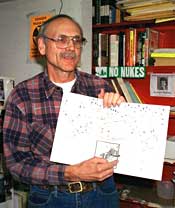| Eighty Years of Serious Contamination No health survey |
About 60 kilometers (38 miles) northeast of the nation's capital, Washington,
DC, on a corner of an old street in Baltimore, the largest city in Maryland,
stands the office of a citizens group of which Richard Ochs (61), a printer,
serves as president.
![]() Growing anxiety among the residents
Growing anxiety among the residents
"The name of the group? It's long so you'll never remember it,"
Ochs leads with a laugh. "We're called the Aberdeen Proving Ground
Superfund Citizens Coalition." His lean body stretches to pull some
material down from a high shelf. "Look. This vast area is the base
we're worried about."
The Aberdeen Proving Ground (APG) is an army base located 30 kilometers
northeast of Baltimore. It is roughly rectangular, about 40 kilometers
(24 miles) long and 8 kilometers (5 miles) wide, fronting Chesapeake Bay.
It opened in 1917 during the First World War and is one of the oldest proving
grounds in the US.
"This place is involved with most of the weapons the army develops.
There's an army research laboratory, too, so they've got research, testing,
training, and storage. It's always been a central, vital base for the army.
In fact, they've been testing depleted uranium (DU) shells here since the
mid-1950s."
However, Ochs first learned about APG testing of DU weapons in 1994. The
Citizens Coalition founded in 1992 originally focused on contamination
from heavy metals and other chemical substances.
"In the 25 years prior to 1979, they were firing at metals used for
tanks and armored vehicles. They did this outdoors, with nothing to keep
the radioactivie dust from blowing toward homes."
The more Ochs and his group learned about the nature of DU penetrators
and the health problems of Gulf War veterans, the more their anxiety grew.
![]() Military discloses nothing
Military discloses nothing
How much DU has disbursed in the air? The army has refused to answer this
question posed by the Citizens Coalition. However, based on army reports
and other data, the Coalition estimates that, until 1979, approximately
11,600 microcuries per month (about 30 kilograms or 66 pounds) of DU was
being discharged into the atmosphere. This is about 77 times the state
standard of 150 microcuries (387 grams or 0.85 pounds) a month.
"After 1979, hard target tests using metal plates were taken indoors.
However, soft target testing into sand is still conducted outdoors,"
Ochs explains. He claims that more than 70 tons of DU have accumulated
at the soft target firing range.
About two million people live near the APG, including the entire population
of Baltimore. The state of Maryland ranks in the top three to five states
in cancer incidence every year. Harford County, adjacent to the base, has
the highest rates in the state. Furthermore, the cancer rate in Delaware,
the state just to the east and downwind from the base, is the highest in
the US.
![]() Fears of compensation
Fears of compensation
"Even though we have all these risk factors at work here, the military
and the state government have never done any sort of health or environmental
survey in the vicinity of the base." Ochs struggles to hide his anger.
"They're terrified they'll have to compensate the residents if the
truth comes to light."
The contamination of all types at the base is such that the national Environmental
Protection Agency has designated it a Super Fund site, thus placing it
among the most contaminated sites in the US. It is a massive dump of radium
gauges and other radioactive substances, abandoned chemical and biological
weapons manufactured during World Wars I and II, five million unexploded
bombs of various sorts, and more.
"Here is where we bury all the negative assets we've accumulated during
eighty years of military activities." As he speaks, Ochs points to
a contamination map of the base produced by the Citizens Coalition. "How
many taxpayer dollars will it take to remove this contamination? And yet,
they keep firing DU munitions, just adding to the contamination and threatening
the lives of the residents. What they are doing is criminal."
Ochs has also been involved in peace activities for forty years. "Environmental
protection is an important element of peace activities." His task
won't end any time soon.


"I'm also worried about the contamination of fish and shellfish around here." Richard Ochs displays a contamination map of the base. (Baltimore, Maryland)